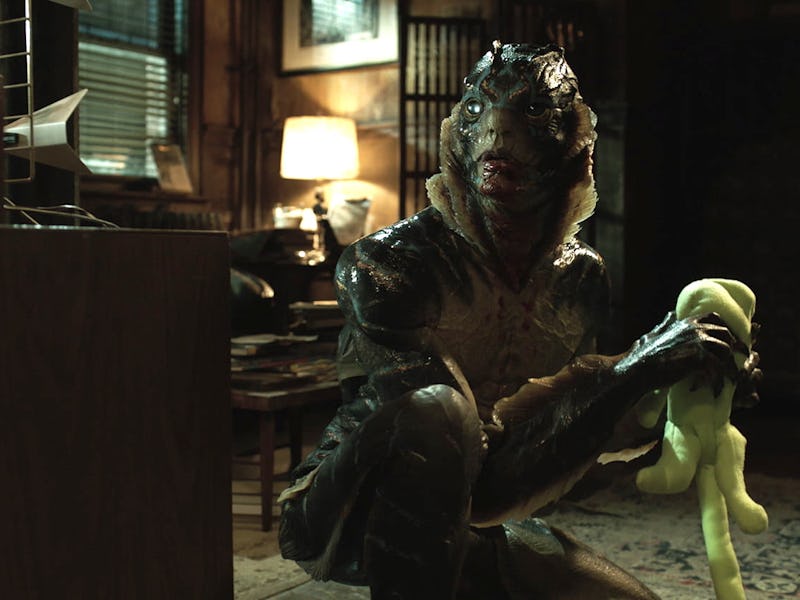'The Shape of Water' Exposes a Disturbing Trend in Genre Stories
Stop the merciless violence against cats.

A disturbing trend has emerged in genre fiction over the last year, with Guillermo del Toro’s Oscar-nominated Shape of Water being one of the most grievous offenders.
Why has genre fiction become so obsessed with mercilessly killing cats in gruesome ways?
Much like dogs, cats have had their place in fiction for as long as they’ve been around, but the last year of cinema and television has seen a peculiar uptick in horrific violence against them. What’s even more strange? Nobody in these stories seems to care.
Take The Shape of Water, for example. Sally Hawkins plays a mute janitor named Elisa that works at a secret research facility. She falls in love with a bizarre fish-man being experimented on. Rather than let him die by vivisection, Elisa instead breaks him out of the facility with the help of her neighbor Giles.
While the three of them hide out, Giles falls asleep and the creature has a confrontation with one of Giles’s many cats. The cat hisses. The creature hisses. When Giles wakes up and goes to investigate, he’s met with this grisly scene:
Someone should tell this fish man that it's not okay to eat cats.
The fish-man eats the head off of the cat, panics, and rushes out of the apartment, slashing Giles’s arm in the process. After nearly an hour spent trying to humanize this fish person, The Shape of Water exposes that it is, after all, some kind of intelligent animal. Rather than rage about this creature killing his pet, Giles makes excuses for the fish man and shrugs it all off as if he thinks, “Hey, I’ve got plenty of other cats anyway.”
Later, Elisa has sex with the fish creature.
So why is this thing deemed man enough to have sex with a human woman, and that’s somehow meant to be okay, but he’s too much of an animal to be held responsible for his behavior? Shape of Water wants us to be titillated by Elisa’s sexual tension with the fish-man, but let’s call their relationship what it truly is: beastiality.
The mistreatment of this cat’s death only proves the fish creature’s inhumanity. And we’ve seen this kind of callous mistreatment of pets emerge in other recent genre stories as well.
Tako is the Makimura family's pet in 'Devilman Crybaby'.
Netflix’s excellent Devilman Crybaby anime presents an anxiety-ridden minor storyline that functions as a sort of visual motif. Akira, the protagonist that becomes a half-demon, half-human “Devilman,” lives with the Makimura family, who own a black cat named Tako. We see the above scene several times throughout the series: the cat paws at his food dish time and time again, meowing for someone to feed him.
As the world gradually devolves into the total chaos of the apocalypse, you can’t help but worry about this cat with increasing anxiety. In one of the season’s final episodes, he’s unceremoniously stabbed with a kitchen knife by home invaders.
He’s eventually resurrected as a “devilcat” with magic powers only to die again in the final fight against Satan.
Alice's young cat explodes, as it's apparently some kind of early warning detection for Lampreys.
Over in Syfy’s The Magicians, a Season 3 plot that’s recently been resolved saw Alice Quinn plagued by a magical fish monster called the Lamprey (fish, apparently, are the eternal enemy of cats). Without magic, Alice has no way to defend herself against the Lamprey, which can possess people. A vampire tells her that she can use young cats to detect the Lamprey — because they’ll explode if the Lamprey gets too close.
When it happens the first time, it’s played off as a bit of shocking dark humor that actually lands pretty well, with Quentin making a half-hearted excuse to a nearby Muggle. Here, the show presents exploding cats as a punchline, which isn’t all that surprising considering its usual humor.
Reynard, a mischievously violent god, also turned one character’s cat inside out in a Season 2 episode.
Which writer on The Magicians just really hates cats?
In 'Stranger Things 2', Dustin might be the real monster.
#JusticeForMews will never get as much traction for Stranger Things 2 as #JusticeForBarb did for the first season, but it warrants mentioning nonetheless.
Dustin, normally most people’s favorite kid in the Stranger Things friend group, has a delusional stretch towards the beginning of Season 2 in which he finds a weird pollywog in his trash that he names D’Artagnan, or Dart for short.
He treats it like a cute new pet, in denial about the fact that it’s clearly a monster from the Upside Down, until he leaves it unattended long enough for Dart to start devouring his family’s ginger cat, Mews.
Granted, this is what causes Dustin to wise up and trap Dart, which is a step in the right direction. But we’re led to believe that Dustin doesn’t really care about the cat, especially when he has a tender reunion with Dart later in the season.
Mews might have been pretty grouchy, but he wasn't all that bad.
RIP Mews, and all the other felines mercilessly lost in the last year.
Why do so many of these characters in genre fiction care more about the catkillers than the actual cats? The characters, and therefore the stories themselves, offer up a bleak perspective about how people treat their animals. It’s about time they started treated these deaths with the same kind of sappy deference we get from dog deaths.